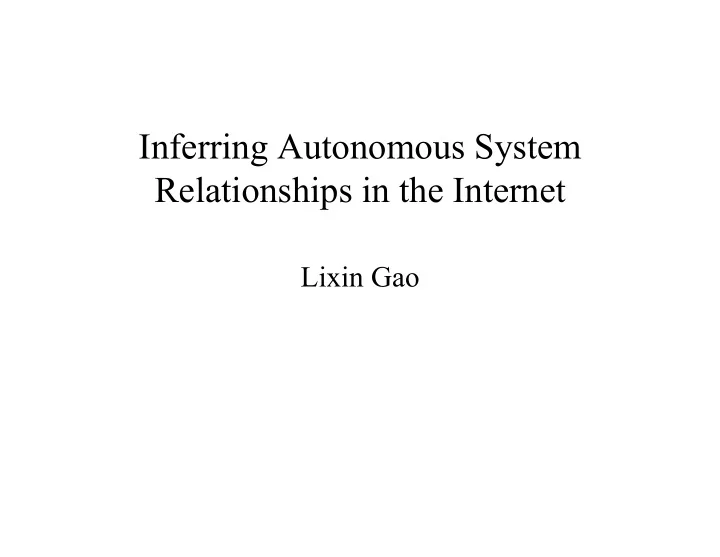

Inferring Autonomous System Relationships in the Internet Lixin Gao
Motivation • Routing policies are constrained by the contractual commercial agreements between administrative domains • For example : AS sets policy so that it does not provide transit services between its providers • Therefore connectivity does not imply reachability • Policies not just connectivity influence the structural properties of the Internet
Background Connectivity between ASes can be modeled using an AS graph G = (V,E) Logical relationship AS1 AS2 AS3 AS4 AS5
AS Relationships • The commercial agreements between pairs of administrative domains can be classified into: – customer-provider relationship – peering relationship – mutual-transit relationship • Classification for relationship of pairs of Autonomous Systems: – customer-to-provider relationship – provider-to-customer relationship – peer-to-peer relationship – sibling-to-sibling relationship
Annoted AS graph Partially directed graph labeled with relationship AS1 AS7 AS6 AS2 AS3 AS4 AS5 provider-to-customer edge peer-to-peer edge sibling-to-sibling edge
Rules governing BGP export policy Own Customer’s Sibling’s Provider’s Peer’s Routes Routes Route Route Route Exporting to × × × a Provider Exporting to × × × × × a Customer Exporting to × × × a Peer Exporting to × × × × × a Sibling Selective export rules indicate that a BGP routing table entry should have a certain pattern
Valley-free property No V-shape possible provider-to-customer edge peer-to-peer edge sibling-to-sibling edge
Valley-free property No Step possible provider-to-customer edge peer-to-peer edge sibling-to-sibling edge
Valley-free property No Step possible provider-to-customer edge peer-to-peer edge sibling-to-sibling edge
Valley-free property AS2 AS6 AS1 AS3 AS4 AS5 provider-to-customer edge AS path (1,2,3) is valley-free peer-to-peer edge sibling-to-sibling edge
Valley-free property AS2 AS6 AS1 AS3 AS4 AS5 provider-to-customer edge AS path (1,2,6,3) is valley-free peer-to-peer edge sibling-to-sibling edge
Valley-free property AS2 AS6 AS1 AS3 AS4 AS5 provider-to-customer edge AS path (1,4,3) is not peer-to-peer edge valley-free sibling-to-sibling edge
Valley-free property AS2 AS6 AS1 AS3 AS4 AS5 provider-to-customer edge AS path (2,1,3,6) is not peer-to-peer edge valley-free sibling-to-sibling edge
Valley-free property • After traversing a provider-to-customer or peer-to- peer edge, the AS path can not traverse a customer-to-provider or peer-to-peer edge.
Routing Table Entry Patterns • Downhill Path: a sequence of edges that are either provider-to-customer or sibling-to-sibling • Uphill Path: a sequence of edges that are either customer- to-provider or sibling-to-sibling
Routing Table Entry Patterns • An AS path of a BGP routing table entry has one of the following patterns: – an uphill path followed by a peer-to-peer edge followed by a downhill path – an uphill path – a downhill path – an uphill path followed by a downhill path – an uphill path followed by a peer-to-peer edge – a peer-to-peer edge followed by a downhill path
Routing Table Entry Patterns uphill top provider downhill top provider u i u i+1 u 2 u n-1 u 1 u n
Heuristic Algorithms • The Algorithm for inferring AS relationships is based on the fact that ASes set up their export policies according to the relationships and on the resulting patterns on BGP routing table entries • It is also based on the intuition that a provider typically has a larger size than its customer and the size of an AS is typically proportional to its degree in the AS graph
Heuristic Algorithms • top provider of an AS path is the AS that has the highest degree among all ASes in the path • we can infer that consecutive AS pairs on the left of the top provider are customer-to-provider or sibling-to-sibling edges and on the right are provider-to-customer or sibling-to-sibling edges
Inference Results TOTAL TOTAL SIBLING- SIBLING- PEER-TO- PEER-TO- ROUTING EDGES TO- TO- PEER PEER ENTRIES SIBLING SIBLING EDGES EDGES EDGES EDGES INFERRED INFERRED INFERRED INFERRED BY FINAL BY FINAL [R= � BY BASIC BY ] [R=60] (PERCENT REFINED (PERCENT (PERCENT AGE) (IGNORED AGE) AGE) ENTRIES) 1999/9/27 968674 11288 149 (1.3%) 124 (25) 884 (7.8%) 733 (6.5%) 2000/1/2 936058 12571 186 (1.47%) 135 (51) 838 (6.7%) 668 (5.3%) 2000/3/9 1227596 13800 203 (1.47%) 157 (46) 857 (6.2%) 713 (5.7%)
Verification of Inferred Relationships by AT&T OUR INFERENCE AT&T INFORMATION PERCENTAGE OF AS Customer Customer 99.8% Peer 0.2% Peer Peer 76.5% Customer 23.5% Sibling Sibling 20% Peer 60% Customer 20% Nonexistent Customer 95.6% Peer 4.4% Comparing inference results from Basic and Final(R= ) with AT&T internal information 8
Verification of Inferred Relationships by AT&T OUR INFERENCE AT&T INFORMATION PERCENTAGE OF AS Customer Customer 99.5% Peer 0.5% Peer Peer 76.5% Customer 23.5% Sibling Sibling 25% Peer 50% Customer 25% Nonexistent Customer 95.6% Peer 4.4% Comparing inference results from Refined and Final(R= ) with AT&T internal information 8
Verification of Inferred Relationships by AT&T OUR INFERENCE AT&T INFORMATION PERCENTAGE OF AS Customer Customer 99.8% Peer 0.2% Peer Peer 100% Sibling Sibling 20% Peer 60% Customer 20% Nonexistent Customer 95.6% Peer 4.4% Comparing inference results from Basic and Final(R=60) with AT&T internal information
Recommend
More recommend